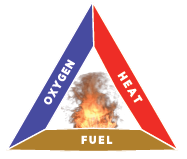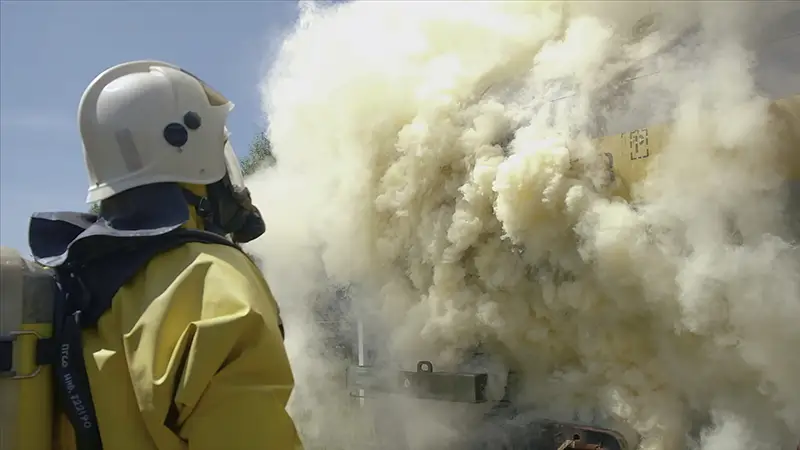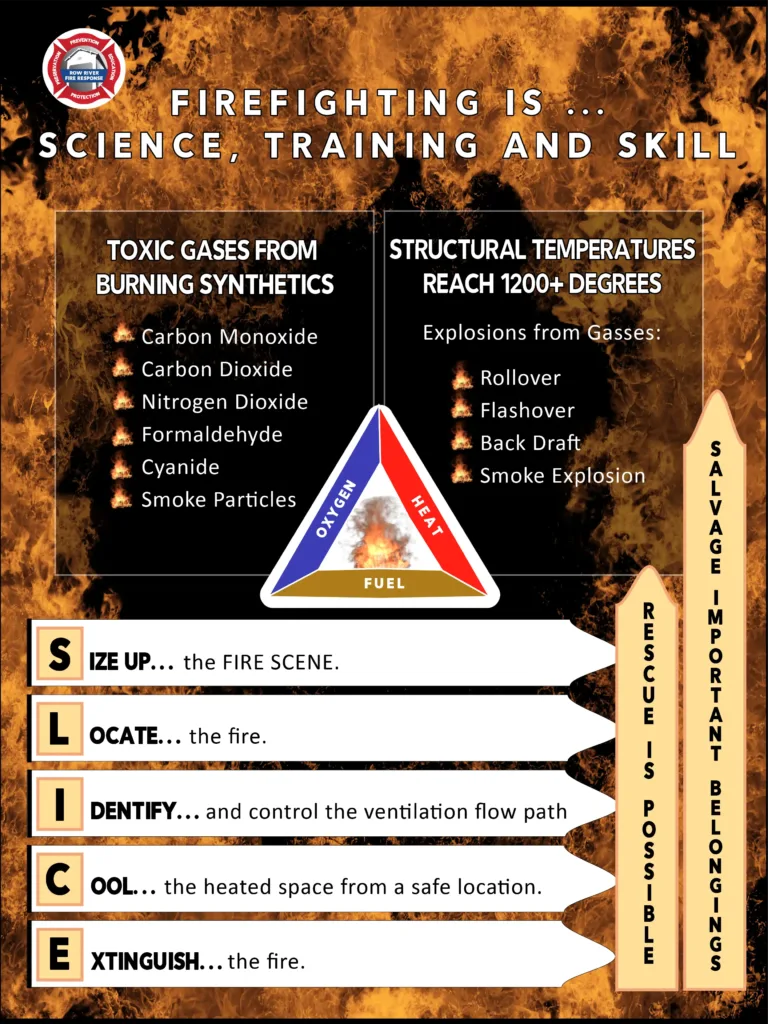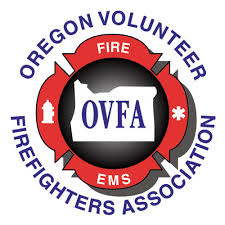Structural fires (house fires) are complicated. Here is some information that all firefighters consider when confronted with a structure fire. Firefighters have a lot to consider when faced with a structure fire!

These gasses are highly flammable, explosive, and accumulate in the upper parts of rooms just waiting for the right conditions to ignite. However, these gasses may not ignite because the fire has already consumed all the oxygen that is available (they are missing enough oxygen in the fire triangle)—like damping down a wood stove. These gasses are superheated, super flammable and just waiting for more oxygen (air) and they will ignite with such force to spread the fire and extreme heat throughout the structure with explosive growth and force. These dangerous conditions are increasing in recent decades due to petroleum-based construction materials in newer homes.
Dangerous fire events include backdraft, flashover, and smoke explosion. These events mirror the combustion of gasoline vapor in a car engine. A flooded engine won’t start because there is too much fuel and not enough air in the cylinder. As soon as the right ratio combination of heat (Sparkplug), fuel- (gasoline vapor), and air are in the right ratios, the product explodes inside the cylinder of the motor with immense force and heat.
If a victim or firefighter is present when this happens in a structure fire the sad reality is they are unlikely to survive. Common ways that these events occur is when a new flow of air gains access by uncontrolled introduction into the fire scene by window breakage, or actions of bystanders (opening a door to the building for example). Air rushes in and the fire triangle is complete for a disaster.
Firefighters are keenly aware of this risk and practice techniques to minimize the risk. For example, rushing into a building and allowing rapid fresh air to the explosive gasses is to be avoided and firefighters strive to control the flow of air into the fire scene as a priority.
The main priority, besides controlling the air flow, is cooling the superheated gasses as quickly as possible with judicious use of water flow. This is done by spraying water streams into the explosive gas layer and allowing the water to cool it down. By cooling the explosive gasses, the risk of explosive fire growth is dramatically reduced, and thus the survivability for victims is improved.

Rather than a rapid direct entry attack of the fire the fastest way to cool these explosive gasses is often a transitional attack from the exterior. Firefighters shoot water through small openings like windows or partially open doors to cool explosive gasses while limiting air flow into the fire scene to minimize the risks of explosive growth. This is why you see firefighters shooting water through windows of buildings up towards the ceilings of interior rooms—they are cooling the explosive gasses to limit fire growth and increase survivability for victims. Fire scene studies have shown that transitional attacks are twice as fast as cooling fire interiors compared to a direct attack. Cooling of the fire gasses equates to quicker victim rescue and survivability, and often less physical damage to one’s home.
The transitional attack may be considered by the first responding company as an exterior offensive tactic to cool flammable gasses and fire conditions as part of the SLICE-RS standard of modern fire attack (see below).
The transitional fire attack is a common effective attack to reduce the fire heat release rate and cool explosive gasses. Compared to direct interior attack, the cooling effect on the fire scene is twice as fast. This improves scene survivability and speeds access for a subsequent interior rescue crew. So, this is why, with newer types of construction and contents in structures, direct interior attacks are less common than in the past. The transitional attack, cooling and venting explosive gasses, controls the fire scene more quickly for subsequent operations including entry and rescue.

Structural Fires have changed in modern built homes for several reasons:
- Petroleum and other synthetic contents are much more prevalent in homes creating greater toxic flammable gasses.
- Super insulated structures with high energy efficiency trap superheated gasses in the building increasing heat for fuels ignition. (autoignition).
- Lightweight building materials are more flammable and burn more quickly producing faster movement and heat of the fire.
- Manufactured homes have lightweight and high resin construction materials that create more flammable gasses.
- Truss roofing systems are more susceptible to failure and collapse.
Older and non-permitted structures are still problematic.
- Lack of fire-retardant components (use of plywood or OSB instead of fire-resistant Gypsum).
- Lack of fire stops in walls.
- False ceilings and other hidden voids from remodels that can hide or allow fire to spread quickly.
- Poorly renovated roofing, or removal of structural materials increasing the risk of fire related collapse.
- Balloon framed construction allowing rapid upward spread of fire.
SLICE-RS
This is a modern sequential standard of initial responder actions when first arriving on the fire scene.
Part of South Lane Fire and Rescue Standard Operating Guidelines.
Rapid application of water is a key component of SLICE-RS
These are the steps of the process:
- Size up. (360–gather data to guide decisions)
- Locate the fire from the exterior. (extent, location, flames visible, etc.)
- Identify Flow Path. (where are the inflow and outflow of air and gasses occurring?)
- Cool from a Safe Location. (Apply water to reduce heat and reduce/remove that part of the fire triangle).
- Extinguish. (Locate the seat of the fire and extinguish).
- Rescue-priority if safe to do so.
- Salvage-protection of buildings from fire response activities when possible.
Cooling the superheated gasses with straight intermittent spray, from an exterior location, reduces heat, cooling superheated gasses, and keeps the flammable gasses separate from the inflow of oxygen in the incoming flow path.
References:
Fire Safety Research Institute
https://fsri.org/research-update/fsri-releases-part-i-fire-attack-study-water-mapping
International Society of Fire Service Instructors-(video)
https://www.youtube.com/watch?v=X80yseC2fmQ&t=26s
Smoke and Fire gasses are extremely dangerous!
Toxic and Explosive Gasses in Smoke contain:
- Carbon Monoxide—highly flammable, odorless and can cause immediate asphyxiation.
- Cyanide—highly flammable, causes immediate death due to asphyxiation 35 times as toxic as Carbon Monoxide.
- Carbon Dioxide displaces available breathable oxygen in structure compartments.
- Formaldehyde—serious irreversible lung damage.
- Nitrogen Dioxide—direct and irreversible microscopic lung damage
- Smoke particulates and unburned fuels—additional explosive potential.
These gasses kill innocent unsuspecting persons on scene when they enter a structure for whatever reason, thinking they are away from the fire, but because the gasses are odorless and invisible the person becomes overwhelmed and succumbs before they are aware—often a fatal event within 12-15 ft of entering the structure.
Types of Explosions of Gasses:
- Rollover—flame fingers propagating thru the hot gasses near the ceiling—indicates impending flashover.
- Flashover–simultaneous ignition of gasses within the structure at all levels- resulting in extensive fire everywhere in the compartment—like an explosion or ignition within an engine cylinder. Extreme fire growth.
- Back Draft—An explosive growth of fire caused by sudden introduction of air flow (oxygen) into a compartment full of superheated gasses. Explosive, extensive fire growth occurs.
- Smoke Explosion—Smoke containing unburned fuel sources can travel to multiple areas of the structure away from the seat of the fire itself. In the right conditions and with an ignition source, explosive fire growth occurs throughout the smoke distribution well beyond the seat of the fire.
Most of these events are not survivable for firefighters even with PPE in place, and unprotected occupants have essentially zero chance of survival. The gas ignitions in these cases have temperatures of 1200F or more degrees.
This is why it is critical for firefighters to mitigate the risks of gas ignition and lower the temperature of the fire compartment as quickly and safely as possible. This is often accomplished more quickly with an initial exterior transitional attack.
Learn more about the common causes of structure fires and how to reduce your risk for fire in an upcoming article to be released soon.
Walt Bernard, President
For the Board
Row River Fire Response
2-28-2024
Thanks for reading and please:
Vote Yes for Fire Protection!
